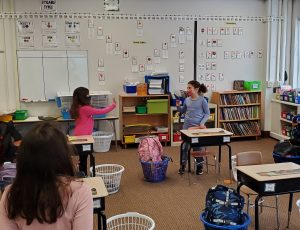Responsive Classroom and The Positivity Project
By Kim KennedyThere are few “programs” that truly transcend teaching and learning. I am fortunate to have learned and used two in my classroom that have become monumental each and every day; they are Responsive Classroom (RC) and The Positivity Project (P2). It’s important to take note that neither of these is specific curriculum or content. We learn early in our teaching careers that creating a classroom community is our number one goal over any content or curriculum. Classroom community is vital, and both RC and P2 put this at the forefront. A guiding principle of RC is that teaching social and emotional skills is as important as the academic content. After all, what child wants to attempt an unknown word in a text when they don’t feel safe, a sense of belonging, or purpose within their classroom? You will find these same beliefs in P2 and its 24 character strengths and the Other People Mindset. These can be weaved together throughout the school day in a variety of ways.
Both RC and P2 support the same outcomes; creating positive relationships and building a community of learners. One of the ways that I have integrated both RC and P2 in my classroom is in our daily Morning Meeting. Morning Meeting is one of the components of RC where the day is started by greeting all members of the classroom, having opportunities to share, do fun activities, and finally end with a message that brings us to the start of our academic day. Morning Meeting is where we become a family of learners. Everyone is greeted and hears their name. We learn about each other in the different ways we share, and we have structured fun through the activities.
I have been able to integrate P2 into every portion of my Morning Meeting. We discuss which character strengths we are using by greeting each other each morning. During the sharing portion, we will often discuss how the weekly character strength is achieved, affects our lives, or how we can use it during our day. Learning so much about each other helps to create empathy and safety. Our conversations bring about a school-wide common language and vocabulary from both RC and P2 — and provide my students with opportunities to use the language.

Similarly, our closing circle (RC) is an opportunity to reflect on our day, both socially and academically. It is here that we have the opportunity to share how we used, or saw the character strengths being used, throughout our day. My students will often point out characters in books we have read. One day in the closing circle my students reflected on a story about Mary Anning, a famous paleontologist we read about that day. My students were able to reflect on the perseverance, bravery, curiosity, and teamwork that she needed to do her job. They saw that it was through these strengths Mary Anning was able to be successful in her career.
Families will often comment about the language their children use and marvel at their dinnertime conversations. It often leads them to ask about how they can reinforce P2 at home. This leads me to another guiding principle in RC; knowing families and valuing their contributions are as important as knowing the children we teach. My school has done school-wide family projects around the P2 character strengths, and we always get an enormous amount of participation followed by stories of the fun they had while doing them. Many families look for more ways to foster P2 at home, and they are so appreciative of the new P2 for Families link.
Due to Covid 19, school as we know it has drastically changed. From starting last spring completely virtual to opening this fall in a hybrid model it became even more important to prioritize my students’ social and emotional well-being. So much of what we know about school had to be reinvented, but what brought me the most comfort was that I didn’t need to reinvent the wheel for how I create a classroom community and address social-emotional learning.
When school first closed last spring, whether or not we were going to have Morning Meeting was one of the very first questions asked by a student. We have been able to have our daily morning meetings through Google Meet. We still do all four components with only small changes in implementation. During the share portion, we discuss how we are feeling, and what character strengths we use to cope. We discuss our need for optimism, gratitude, perseverance, social intelligence, and much more. On hybrid days, students still listen to a story, create something, or play a game that highlights the weekly character strength. Instead of classroom discussion, they are typing their thoughts into Google Classroom. Not surprisingly, P2 is often the first “assignment” my students do on their hybrid days. This tells me the value they place on it.
When we look at this pandemic from a different perspective, we do find positives. I see my students being more in tune with each other, recognizing the importance of our moments together, and genuinely caring for each other in a deeper way. There has been much worry about how Covid will affect our students academically in the long run. I have hope and confidence that these students will value their positive relationships like no other generation. They will appreciate the value of spending time with family and friends, valuing others’ perspectives, and caring deeply for their community as a whole. I can confidently say that this is in large part because of using the Responsive Classroom approach along with The Positivity Project in my classroom.


